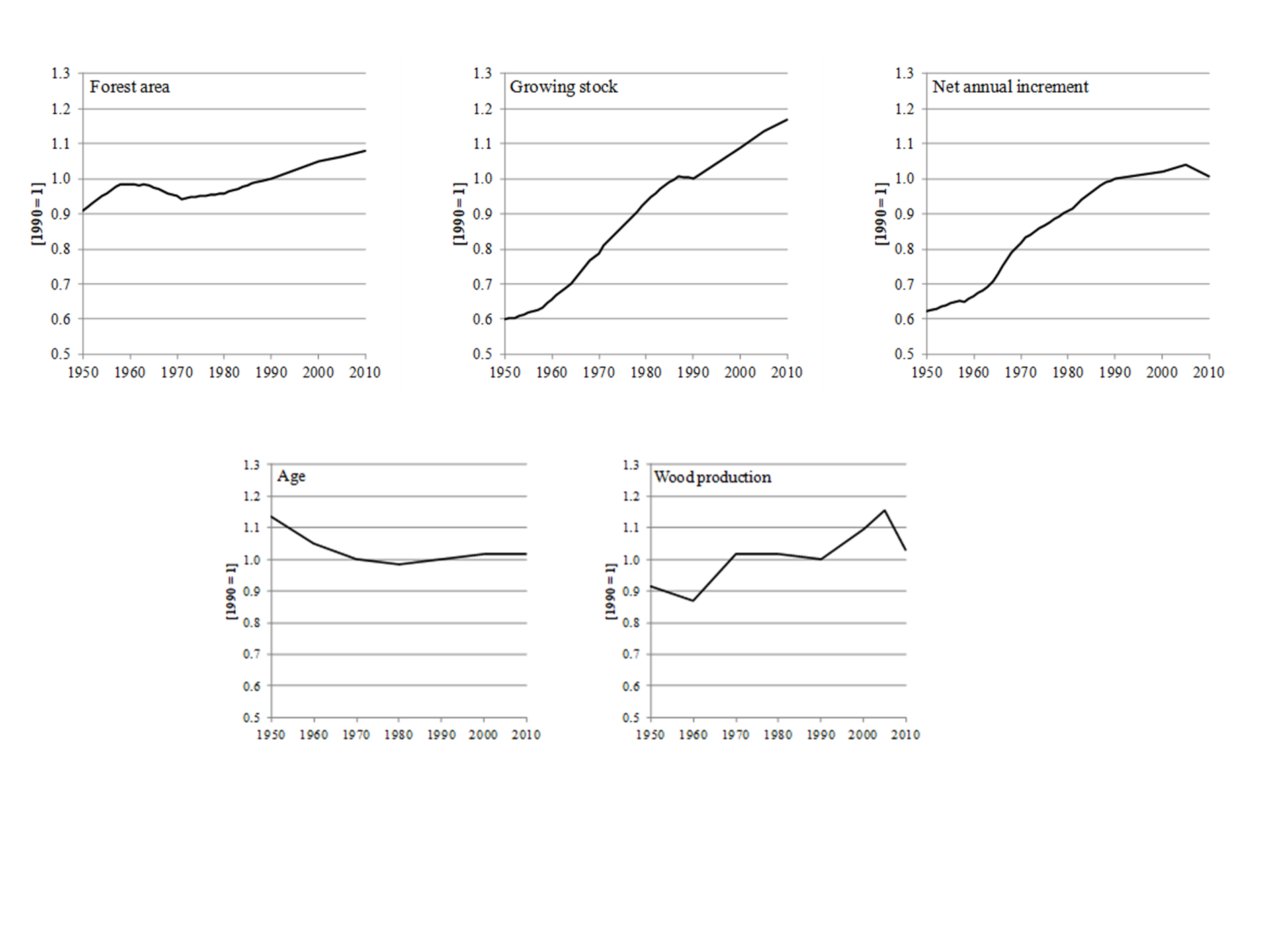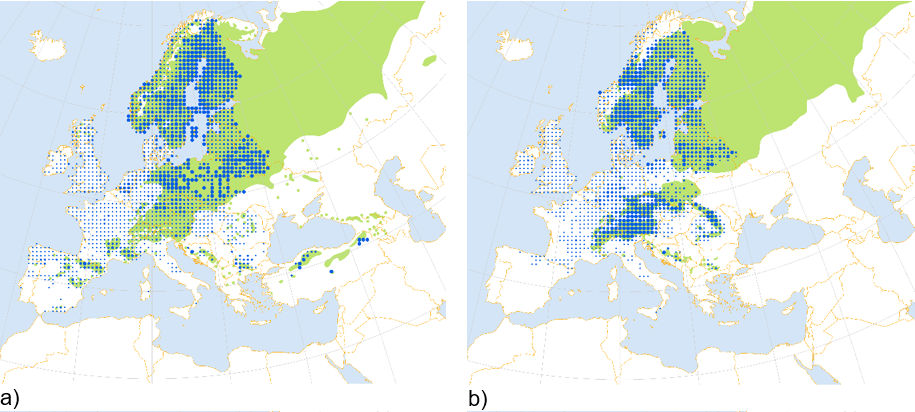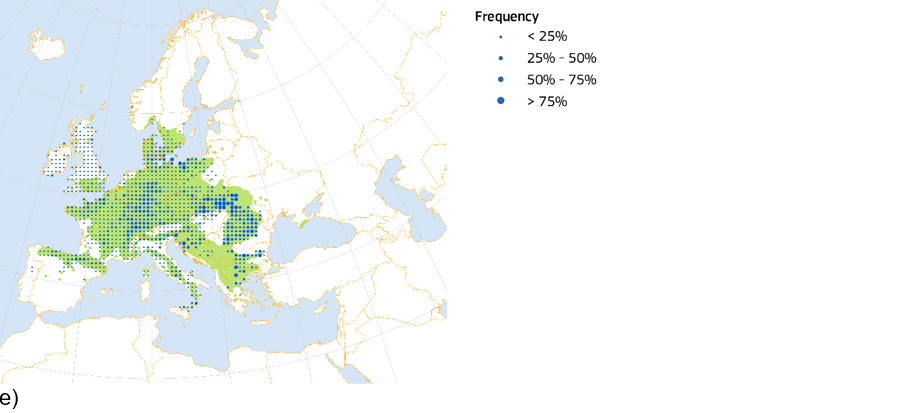Authors: Marcus Lindner (EFI), Elisabeth Pötzelsberger (EFI), Hans Verkerk (EFI)
Forests in the EU have seen major changes over time. Intensive land use practices have resulted in major losses of forest cover in this part of the world during the last centuries to millennia (Bradshaw, 2004; Kaplan et al., 2009). Trends in forest cover change have reversed in Europe, however, and the forest area has been expanding during the 20th and 21st century (Gold et al., 2006; Kuusela, 1994; Rautiainen et al., 2010; Fuchs et al., 2013; Forest Europe, 2011; Rudel et al., 2005; Kuemmerle et al., 2016).
The forest resources in the EU currently cover 159 million ha or around 40% of the land area, which corresponds to four times the total area of Sweden (Forest Europe, 2020). The share in forest cover is largest in the Nordic countries with a forest cover of 74% and 69% in Finland and Sweden respectively, whereas it is as little as 11% in Ireland and the Netherlands and 1% in Malta. The average timber volume (growing stock) is 162 m3 per hectare of forest. The average growing stock varies from 60 m3 per hectare in Spain to 390 m3 per hectare in Luxembourg.
Besides change in the extent of forest in Europe, the structure of these forest resources has also been changing (Figure 1). The growing stock and increment rates have been increasing almost continuously over the last decades (Gold et al., 2006; Kuusela, 1994; Rautiainen et al., 2010; Forest Europe, 2011), although the increment rates have started to level off in recent years (Nabuurs et al., 2013; Camia et al., 2018). Factors contributing to increasing increment rates have been a topic of scientific debate and include the improved accuracy of forest inventories, nitrogen deposition, increased atmospheric carbon dioxide (CO2) concentrations, changes in climate, cessation of grazing and litter raking, ageing of the forest resources and changes in, or lack of, forest management (Gold et al., 2006; Ciais et al., 2008; de Vries and Posch, 2011; Luyssaert et al., 2010; Bellassen et al., 2011; Nabuurs et al., 2003). The effects of age, as well as the single effect of increased atmospheric CO2 concentrations have been disputed (Körner et al., 2005; Erb et al., 2013; Vilén et al., 2012). The results of monitoring and modelling studies now suggest that the main drivers are forest management (Erb et al., 2013; Vilén et al., 2012) and nitrogen deposition (Fernandez-Martinez et al., 2014; de Vries et al., 2014; de Vries et al., 2009; Etzold et al., 2020), as well as the combined effect of nitrogen deposition, increased atmospheric CO2 concentrations and climate change (Pretzsch et al., 2014; Flechard et al., 2020).
Figure 1: Changes in area, growing stock per hectare, net annual increment per hectare, age and annual wood removals per hectare in European forests. Data are indexed to the year 1990 (i.e. 1990=1). Source: Verkerk, 2015.
The rate of wood harvesting has also been increasing over recent decades, but at a slower pace than the increase in wood increment. Currently, about 75% of the net annual growth is felled, but with a large variation across regions (Levers et al., 2014). As the annual increment exceeds fellings, the amount of wood and biomass standing in Europe’s forests has been increasing continuously since the end of the Second World War. As a result, European forests have been acting as a carbon sink for decades, i.e. they have removed more carbon from the atmosphere through photosynthesis than the amount that was released back to the atmosphere through decomposition and burning (Nabuurs et al., 2013; Nabuurs et al., 2003; Goodale et al., 2002).
Wood production is an important forest function and wood removals from all EU forests reached 497 million m3 (under bark) in 2019. However, European forests are managed for a range of purposes and objectives. Some European regions are managed with the main aim to produce wood, while other regions have other objectives besides wood production (Hengeveld et al., 2012; Nabuurs et al., 2019). Since the 1990s, there has been a trend towards more close-to-nature silviculture and nature-oriented forest management, although this is implemented in many ways. While in the past, forests were predominantly managed as simple, evenaged- forests, management nowadays aims to increasingly develop more structurally rich forests. Clearcutting with tree retention (typically 5-10 trees per ha) is still the dominant cutting regime especially in the north of Europe, but there is a move away from clearcutting towards small-scale harvest and selective cutting of individual or groups of trees, especially in Central and South-Eastern European countries. When clearcutting is applied, harvesting cycles can go from 10 to 30 years in the case of fast-growing species (poplar, eucalyptus, some pine or spruce species), but typically exceed 80 years, ranging up to more than 200 years in Central Europe.
Tree species selection is another major management choice. For centuries, land managers, including foresters, favoured relatively few tree species for timber and fuelwood production, as well as other amenities. As a result, European forests deviate substantially from the potential natural vegetation. However, a shift towards a larger share of broadleaved species can be observed, especially in Central Europe. Motivated by the realization of the susceptibility of coniferous forests to storm, wildfire and insect outbreaks and climate change, forest managers have been increasingly favouring broadleaved or mixed species since the 1990s.
At the European level, economically important and widespread tree species include Scots pine (Pinus sylvestris L.), Norway spruce (Picea abies (L.) Karst.), Pedunculate and Sessile oak (Quercus robur L. and petraea (Matt.) Liebl.) and European beech (Fagus sylvatica L.). Especially Scots pine and Norway spruce are conifers that have been established outside their natural range; their current distribution extends more west and south than their natural distribution (Figure 2) (San-Miguel-Ayanz et al., 2016; Spiecker, 2003). Foresters have generally preferred these two species over broadleaved species (see box), including European beech and Pedunculate and Sessile oak, which would naturally dominate a large extent of Europe’s forests.
Figure 2. Distribution of Scots pine (a; Pinus sylvestris L.), Norway spruce (b; Picea abies (L.) Karst.), pedunculate oak (c; Quercus robur L.), sessile oak (d; Quercus petraea (Matt.) Liebl.) and European beech (e; Fagus sylvatica L.), according to observations in national forest inventories and their native range. Source: San-Miguel-Ayanz et al., 2016.
Tree species composition is, however, not always a direct management choice. Especially in southern Europe, forests have been established in recent decades through natural forest expansion following the abandonment of agricultural practices. The tree species composition of such forests is determined, amongst many other factors, by the availability of seeds and the ability of species to reach and occupy new sites. Also, high ungulate densities often lead to failures of deciduous species as they are selectively browsed by e.g. roe and red deer populations. Furthermore, the historical expansion of agriculture typically occurred on fertile and easily accessible areas. The forests and tree species that remained are typically those species that can grow on less fertile soils or in harsher conditions.
--------------------------------------------------------
Why were Scots Pine and Norway Spruce planted outside their natural range historically?
- Better ability to grow and produce sufficient timber on degraded soils depleted of nutrients by previous agricultural uses such as litter raking and grazing.
- Faster tree growth enabled meeting in a shorter time the increasing wood demand of a growing population and the higher wood demand after wars for reconstruction and reparation payments.
- Better energy efficiency of timber processing and usability for high quality products due to stem straightness and fibre length, as well as fewer defects like knots, colouration, tensions and twists in the wood. Timber from pine and spruce was in higher demand, both from sawmills as well as pulp and paper mills.
- Silvicultural management to produce good quality timber was easier.
--------------------------------------------------------
References
Bellassen, V., et al., (2011). Reconstruction and attribution of the carbon sink of European forests between 1950 and 2000. Global Change Biology. 17(11): p. 3274-3292.
Bradshaw, R.H.W., (2004). Past anthropogenic influence on European forests and some possible genetic consequences. Forest Ecology and Management. 197(1–3): p. 203-212.
Camia, A., et al., (2018). Biomass production, supply, uses and flows in the European Union. First results from an integrated assessment, EUR 28993 EN. Publications Office of the European Union: Luxembourg.
Ciais, P., et al., (2008). Carbon accumulation in European forests. Nature Geoscience. 1(7): p. 425-429.
Erb, K.-H., et al., (2013). Bias in the attribution of forest carbon sinks. Nature Climate Change. 3(10): p. 854-856.
Etzold, S., et al., (2020). Nitrogen deposition is the most important environmental driver of growth of pure, even-aged and managed European forests. Forest Ecology and Management. 458: p. 117762.
Fernandez-Martinez, M., et al., (2014). Nutrient availability as the key regulator of global forest carbon balance. Nature Climate Change. 4: p. 471-476.
Flechard, C.R., et al., (2020). Carbon–nitrogen interactions in European forests and semi-natural vegetation – Part 1: Fluxes and budgets of carbon, nitrogen and greenhouse gases from ecosystem monitoring and modelling. Biogeosciences. 17(6): p. 1583-1620.
Forest Europe, UNECE, and FAO, (2011). State of Europe's forests 2011. Status and trends in sustainable forest management in Europe. 2011, Ministerial Conference on the Protection of Forests in Europe. Forest Europe liaison unit Oslo: Ås. p. 337.
FOREST EUROPE, (2020). State of Europe’s Forests 2020.
Fuchs, R., et al., (2013). A high-resolution and harmonized model approach for reconstructing and analysing historic land changes in Europe. Biogeosciences. 10(3): p. 1543-1559.
Gold, S., A. Korotkov, and V. Sasse, (2006). The development of European forest resources, 1950 to 2000. Forest Policy and Economics. 8(2): p. 183-192.
Goodale, C.L., et al., (2002). Forest carbon sinks in the Northern hemisphere. Ecological Applications. 12(3): p. 891-899.
Hengeveld, G.M., et al., (2012). A forest management map of European Forests. Ecology and Society. 17(4).
Kaplan, J.O., K.M. Krumhardt, and N. Zimmermann, (2009). The prehistoric and preindustrial deforestation of Europe. Quaternary Science Reviews. 28(27–28): p. 3016-3034.
Körner, C., et al., (2005). Carbon flux and growth in mature deciduous forest trees exposed to elevated CO2. Science. 309(5739): p. 1360-1362.
Kuemmerle, T., et al., (2016). Hotspots of land use change in Europe. Environmental Research Letters. 11(6): p. 064020.
Kuusela, K., (1994). Forest resources in Europe. European Forest Institute research report 1. Cambridge: Cambridge University Press. 154.
Levers, C., et al., (2014). Drivers of forest harvesting intensity patterns in Europe. Forest Ecology and Management. 315(0): p. 160-172.
Luyssaert, S., et al., (2010). The European carbon balance. Part 3: forests. Global Change Biology. 16(5): p. 1429-1450.
Nabuurs, G.J., et al., (2003). Temporal evolution of the European forest sector carbon sink from 1950 to 1999. Global Change Biology. 9(2): p. 152-160.
Nabuurs, G.-J., et al., (2013). First signs of carbon sink saturation in European forest biomass. Nature Climate Change. 3(9): p. 792-796.
Nabuurs, G.-J., et al., (2019). Next-generation information to support a sustainable course for European forests. Nature Sustainability. 2(9): p. 815-818.
Pretzsch, H., et al., (2014). Forest stand growth dynamics in Central Europe have accelerated since 1870. Nature Communications. 5.
Rautiainen, A., L. Saikku, and P.E. Kauppi, (2010). Carbon gains and recovery from degradation of forest biomass in European Union during 1990-2005. Forest Ecology and Management. 259(7): p. 1232-1238.
Rudel, T.K., et al., (2005). Forest transitions: towards a global understanding of land use change. Global Environmental Change. 15(1): p. 23-31.
San-Miguel-Ayanz, J., et al., eds. (2016). European atlas of forest tree species. Publication Office of the European Union: Luxembourg.
Spiecker, H., (2003). Silvicultural management in maintaining biodiversity and resistance of forests in Europe—temperate zone. Journal of Environmental Management. 67(1): p. 55-65.
Verkerk, P.J., (2015). Assessing impacts of intensified biomass removal and biodiversity protection on European forests. Dissertationes Forestales 197. University of Eastern Finland.
Vilén, T., et al., (2012). Reconstructed forest age structure in Europe 1950-2010. Forest Ecology and Management. 286: p. 203-218.
de Vries, W. and M. Posch, (2011). Modelling the impact of nitrogen deposition, climate change and nutrient limitations on tree carbon sequestration in Europe for the period 1900-2050. Environmental Pollution. 159(10): p. 2289-2299.
de Vries, W., et al., (2009). The impact of nitrogen deposition on carbon sequestration by European forests and heathlands. Forest Ecology and Management. 258(8): p. 1814-1823.
de Vries, W., et al., (2014). Impacts of acid deposition, ozone exposure and weather conditions on forest ecosystems in Europe: an overview. Plant and Soil. 380(1-2): p. 1-45.



